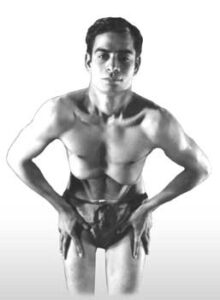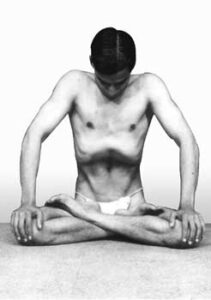What is uḍḍīyana-bandha (abdominal hold)?
Uḍḍīyana is a bandha (hold) and not an āsana. Importantly, āsana is a pose which yeilds specific benefits by directing the flow of prāṇa to a particular part of the body, energising it. However, bandha is a hold, where the flow of prāṇa is obstucted. As a result, the kundalini begins to move. In fact, though there are physiological benefits in these bandhas, most of the benefits are for ensuring higher yoga goal.
What does Hatha Yoga Pradeepika say on uḍḍīyana-bandha
Ch2 v 55 uḍḍīyana-bandha: Yogis call it uḍḍīyana-bandha because when practiced, prāṇa flies through it to the sushumna.

Ch2 v 56 Because the great bird (prāṇa) flies up continuously, it is called uḍḍīyana (ut = fly + di = up). The bandha is now explained.
Ch2 v 57 The abdomen is drawn westwards so the navel moves up. Uḍḍīyana is like a lion for the elephant of death.
Ch2 v 58 One that practices uḍḍīyana after attaining familiarity as learned from a guru, even if old will become young.
Ch2 v 59 Draw back the abdomen above and below the navel with effort. After practice of 6 months, when one has mastered it death is conquered.
Ch2 v 60 Of the bandhas, uḍḍīyana is most excellent. When it is perfected, mokṣa follows naturally.
How to practice uḍḍīyana-bandha? (technique should be learned under supervision)
- Starting (sthithi) position: Stand erect with legs slightly apart and hands to the side.
- Bend forward and place hands on thigh, some 6 inches below the hip joint.
- Vigorously breathe out and empty the lungs of air. This means breathe out till the diaphragm rises to its top most position in the thoracic cavity.
- When you feel lungs are completely empty, suck stomach inward vigorously towards the spine as far as possible.
- Hold for as long as is convenient.
- Breathe in slowly and release stomach back to normal.
- Stand erect and bring hands to the sides.
- Repeat 3 to 6 times.
- The dṛṣṭi (gaze) recommended is nabhigre (middle of the navel) for beginners and nāsikāgra (tip of the nose gaze) for spiritual levels of practice.
What are the benefits of uḍḍīyana-bandha practice?
- When stomach is sucked inwards, the ascending, descending and transverse colon and intestines are pulled back and upwards towards the spine. The rectus and oblique abdominal muscles are also pulled inwards. Also, the small intestines and other organs such as spleen, pancreas and stomach get pushed towards the spine. This energises the complete abdominal viscera and tissues holding them together in the abdominal cavity.
- Consequently, faecal matter in the large intestine gets pushed towards the colon by peristalsis. As a result, diseases related to acidity, piles and constipation get addressed by practice of this exercise.
- The rectus and oblique muscles of the abdomen and the inguinal ligament are rejuvenated.
- Since the action of completely emptying the lungs and push of the diaphragm inwards increases the stroke of the diaphragm, practice of uḍḍīyana helps increasing lung capacity and efficiency.
- Uḍḍīyana also energises and stimulates the cartilages of the spine, sympathetic and parasympathetic nervous system.
- This exercise rejuvenates all major organs such as pancreas, liver, kidneys etc.
- The primary benefit of this banda is to raise the kundalini, but this is for advanced practitioners and should be done under the supervision of a master (Guru).

Yogacharya Sundaram demonstrating the Moola + Jaladhara + Uḍḍīyana banda
What are the possible contraindications of uḍḍīyana-bandha practice?
- If you have any form of back ache, do not attempt this bandha without adequate supervision and support.
- People with hernia, cardiac problems, lower back problems and circulatory disorders should not attempt this bandha without first consulting a physician.
- This bandha should not be practiced during menstruation or pregnancy.
Some noteworthy points on uḍḍīyana-bandha
Internal Links: Dharma (conditioning), Stress and Situational Awareness, Prāṇa, Asana overview, Asana practice, Asana Focus or gazing, Prāṇayama, Hatha Yoga Pradeepika
External Links: Prāṇa, Chakra, Pancha Tattva, Pancha Prāṇa, Pancha Kosha, Nadi,
- This bandha can be performed in some variations. The first method is when suction is performed when bending forward in the standing position. Another method is to sit in padmāsana and perform uḍḍīyana. The last method is to combine uḍḍīyana-bandha with mūla-banda and jalandhara-bandha.
- People with hernia, renal disease should avoid this exercise. Those with stomach ailments should increase pressure slowly.
- This exercise should not be performed by pre-puberty practitioners according to Yoga Mīmāṃsā journal.
